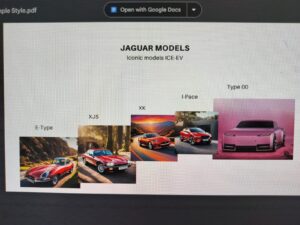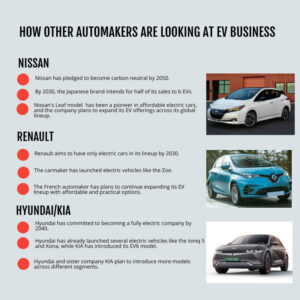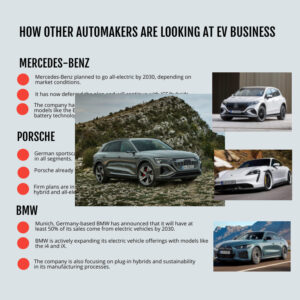Jaguar’s recent rebranding and electrification strategy, particularly its commitment to becoming a fully electric brand by 2025/26, has sparked significant debate within the automotive community. While it’s clear that the company is attempting to stay ahead of the curve in a rapidly changing market, there are several key concerns and challenges that stakeholders, analysts, and enthusiasts are raising. Chandan Bau Mallik takes a closer look at the reasons behind the discussion and the ground realities facing Jaguar and its future trajectory.

The Shift to Electric and the 100% Transition Debate
Jaguar’s Bold EV-only Future: The company has committed to making Jaguar a 100% electric brand by 2025, meaning the company will phase out internal combustion engine (ICE) vehicles entirely. While this is an ambitious and forward-thinking move, analysts question whether this drastic transition could be profitable in the long run.
UK Export Finance backs new commercial loan to Jaguar Land Rover to support its investment plans, including the company’s ambitious electric vehicle plans.
Is it too much too soon?
While admirable, Jaguar’s sudden move to an entirely electric model comes at a time when many countries and consumers are still not fully on board with EVs. Will Jaguar be able to sustain the brand’s identity and continue to drive demand while transitioning away from the ICE models that it is historically known for? Critics wonder if Jaguar’s bold leap could alienate loyal customers who still love the heritage of the brand’s ICE models.
How other automakers are looking at EV business

Exclusive Technology and Unique Offerings
What sets Jaguar apart in the crowded EV market? Companies like Tesla, Rivian, Lucid Motors, and traditional automakers (BMW, Mercedes-Benz, Audi, etc.) are already well into their EV strategies. So, the question arises: what unique value does Jaguar offer to stand out in the increasingly competitive luxury electric vehicle market?
Jaguar will need to demonstrate something truly exclusive or game-changing in its electric offerings—be it through cutting-edge technology, performance, luxury features, or innovation that other automakers haven’t been able to match. Without a clear point of differentiation, it could struggle to carve out a niche in a rapidly growing and competitive market.
Miami announcement
While some automakers are now scaling back their plans or delaying timelines for new factory constructions and product launches to better align with market realities. In December 2024, at Miami, JLR introduced an unmistakable, unexpected and dramatic physical manifestation EV concept called Type 00 (pronounced Type Zero Zero).
Punters have a point.
Rebranding an iconic brand like Jaguar is a delicate process because the brand likely holds significant equity, emotional value, and recognition in the ICE market.
Why not start with a completely new brand instead of destroying the Jaguar brand? Most people can relate to and know what it stands for. They opine that there was no need to put all the eggs in one EV-only basket.
How other automakers are looking at EV business

Jaguar’s Brand Heritage and Rebranding Dilemma
Rebranding an Icon: Jaguar has a long legacy of producing luxury sports cars and iconic models like the XK120 and E-Type. The company’s shift to an all-electric future raises concerns about whether rebranding could risk destroying the brand equity built over decades.
Is it the right move to change Jaguar’s identity completely?
Some argue that Jaguar’s heritage as an ICE performance brand holds significant emotional value, and rebranding it as a purely electric luxury brand might dilute its classic appeal. Could the company have achieved its electric ambitions without completely altering the Jaguar identity? Some suggest that Jaguar could have launched a new EV sub-brand or a distinct EV-focused division instead of rebranding the core brand.
Challenges in EV Market and Supply Chain Issues
Supply Chain Disruptions: The global EV market faces several hurdles, particularly around supply chain constraints. Shortages of semiconductors and raw materials like lithium, cobalt, and nickel are impeding the production of EVs. This is causing delays and bottlenecks in the rollout of electric vehicles across many brands, including Jaguar.
Jaguar must strengthen its supply chains and ensure reliable sourcing of critical materials to meet the growing demand for EVs. Manufacturing and logistics will be key challenges to overcome, especially with the £15 billion investment planned for future production. The UK government is also supporting the JLR EV program with funds. The carmaker has already received a £500 million Export Development Guarantee loan to support Jaguar Land Rover’s plans to invest about £2.5 billion a year, expected to reach £3 billion by March 2026.
Affordability and Profitability Concerns
Price Point and Market Penetration:
One of the ongoing issues with electric vehicles in general is their high price point, which has made them less accessible to the mass market. As a luxury brand, Jaguar’s EV models will likely carry premium pricing, but the question remains: Can Jaguar sell enough EVs to justify the massive investments?
While the company is aiming for high-end luxury EVs, analysts are asking whether Jaguar can reach the sales volume (e.g., 30,000 units per year) necessary to stay financially viable in the EV market, especially when affordability remains a key barrier to EV adoption for many consumers.
In markets like the U.S., where ICE vehicles still dominate and EV adoption has been slower, Jaguar will need to strategically position its EV models to appeal to an audience that might be more hesitant to make the switch to electric. Plus there’s fierce competition from brands from China, Korea and other Asian countries.
EV Competition and Global Challenges
Jaguar’s key competitors:
Jaguar’s luxury EVs will compete with Tesla, Lucid Motors, BMW, Mercedes-Benz, Audi, and even upcoming Chinese electric automakers. These brands already have well-established EV models with strong technology and performance offerings.
Jaguar faces stiff competition in markets like Europe and China, where EV adoption is strong. However, Jaguar’s EV transition will be much harder to sell in markets like the U.S., where there is still a significant preference for ICE vehicles.
Jaguar will need to highlight its unique value proposition, whether through superior design, performance, sustainability, or brand prestige, to succeed in these competitive markets.
Economic and Political Factors/risks
Political and Regulatory Concerns:
Political changes in the UK and regulatory changes in various countries could potentially affect Jaguar’s EV transition plans. For instance, the Zero-Emission Vehicle (ZEV) mandates and tax incentives could either support or hinder Jaguar’s EV strategy, depending on how policies evolve.
The political landscape and shifting consumer demand for EVs could pose a significant risk to Jaguar’s ambitious plans. For instance, the UK’s EV sales targets could affect the company’s investments in its home market.
Luxury and Brand Identity in the future
A New Vision for Luxury:
Jaguar’s future retail strategy will revolve around a global network of luxury retailers and exclusive brand stores. The company aims to set up flagship stores in prime locations like Paris’ luxury district to cater to high-end consumers.
Jaguar’s challenge will be to balance the brand’s heritage and its new electric identity while ensuring that it remains fresh and relevant to modern consumers.
How other automakers are looking at EV business

Future Outlook:
According to the company, Jaguar’s rebranding and commitment to becoming an all-electric luxury brand by 2025/26 is undoubtedly ambitious and forward-thinking. However, the company faces various challenges, including competition, affordability, supply chain issues, and potential risks to its established brand equity. The road ahead will require careful execution, clear differentiation in its EV offerings, and effective management of the transition from ICE to electric without alienating its loyal customer base.
Time will tell whether Jaguar can successfully navigate these challenges. It will depend on how well it can balance its heritage with innovation, meet the evolving demands of the EV market, and differentiate itself in the growing luxury EV space. Will the new Jaguar be able to recreate its ICE legacy? Punters, custodians, and stakeholders will be watching closely as chapters unfold.

Image Courtesy
The post uses all third-party images to make it reader-friendly. The author never claims ownership of any of them. Image courtesy is given to every image used in the story. Prime Avenue, a professional content writing agency, is dedicated to providing readers with the latest updates and information through quality content.
Please read our other automobile blogs at our blog page
About the author:
British-Indian Chandan Basu Mallik has been an automotive petrol head and journalist/editor for over thirty years. He has worked in the UK and the Middle East and is currently in India. You can learn more about his work on his LinkedIn profile: https://www.linkedin.com/in/chandan-mallik-34aa47320/. You can write to Chandan at theprimeavenuekol@gmail.com